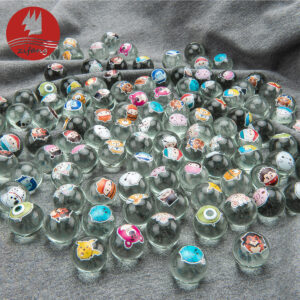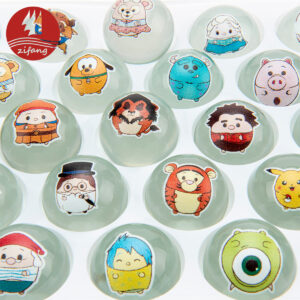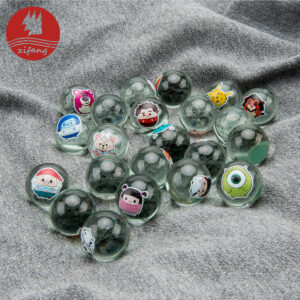Glass marbles have a fascinating history that dates back to almost 5,000 years ago. From being used in ancient games to becoming popular collectibles, glass marbles have come a long way. In this post, we will take you through the journey of glass marbles and their cultural significance. We will also dive deep into the material used in making glass marbles and understand the different types of glass used in marble making. This post will guide you through the traditional handmade process as well as modern machine-made techniques to make glass marbles. We will also provide a step-by-step guide on how you can make your own glass marbles at home and discuss some creative ideas for using them. Lastly, we will touch upon the safety measures that need to be followed while making glass marbles and how the marble-making process has evolved over time.
The Fascinating History of Glass Marbles
Glass marbles have a fascinating history that can be traced back to ancient Rome, where they were used in marble games. They held cultural significance and were seen as symbols of luck, power, and protection in many societies. In the 19th century, glass marbles emerged as a popular alternative to earlier stone and clay marbles. The term “marble” may have originated from the ancient Greek word “marmaros,” which means “shining stone.” Marbles have been crafted using various materials such as molten glass, quartz, and soda lime. Glass marbles continue to be popular today and are collected by enthusiasts all over the world for their unique designs and historical significance.

Origin and Evolution
The origins of glass marbles can be traced back to ancient Egypt where small round beads were made using molten glass. As time progressed, the size of marbles increased, and they were predominantly created from scrap glass or other glass components. The production process also evolved from being handmade to machine-made. With advancements in glass-making technology and the establishment of glasswork studios, marble-making became more intricate, resulting in a wide variety of colorful designs. This evolution in the marble-making process showcases the progress made in the field of glassmaking technology over time.
Cultural Significance
Marbles have been an integral part of various cultures worldwide, ranging from ancient traditions to modern-day gaming. Their small glass orbs have held spiritual and symbolic meanings throughout history and continue to inspire art, literature, and traditional ceremonies. Marbles’ cultural significance can also be observed in popular culture, as they are referenced in classic literature and featured on social media and gaming platforms like Facebook and YouTube. The enduring influence of marbles is a testament to their ability to transcend time and remain relevant in diverse cultural expressions. Whether used for play or revered as sacred objects, these small yet powerful glass orbs continue to captivate people’s imaginations across the globe.
Understanding the Material - Glass
Glass is a versatile material that can be molded into various shapes by heating silica, soda lime, and other components to high temperatures. Marbles, which can be colored, transparent, or opaque, are made from glass using techniques such as rollers, torches, and furnaces. The process involves shaping the molten glass into spheres and cooling them in ice water. Different types of glass like borosilicate and quartz can be used to create marbles with unique properties.
Borosilicate glass is highly resistant to thermal shock and is often used to make laboratory equipment. Quartz glass is even more durable than borosilicate and is commonly used in high-temperature applications like furnace tubes. Glass marbles come in different sizes and styles, with some featuring intricate designs or patterns inside the sphere. Glass marbles are not only used for games but also for decorative purposes like vase fillers or paperweights. With its versatility and adaptability, glass continues to be a popular material for creating beautiful and functional objects.
What is Glass?
Glass is a versatile amorphous solid that can be molded into various shapes due to its unique properties. Its composition, which primarily consists of silica and soda lime, determines its specific characteristics. The production process involves melting the raw materials at high temperatures to create the molten glass, which is then shaped and cooled to form the final product. Glass has been used for centuries for various purposes, including windows, mirrors, bottles, and decorative objects. It is also a popular material for making marbles due to its smooth surface and reflective properties. The durability and transparency of glass have made it an essential material in modern construction and manufacturing industries.
Different Types of Glass Used in Marble Making
The game of marbles owes its diverse range of colors and patterns to the variety of glass types used in their production. Soda-lime is a popular choice due to its ability to produce vibrant hues and ease of manipulation. On the other hand, borosilicate is known for its durability and thermal resistance, making it an excellent option for outdoor play. Quartz, with its exceptional clarity and purity, produces flawless marbles that are highly coveted by collectors.
Each type of glass material has unique properties that contribute to the intricate gameplay of marbles. The size, weight, and surface texture of marbles can vary significantly based on the type of glass used in their production. For instance, soda-lime marbles tend to be slightly larger and have a smoother surface compared to borosilicate marbles, which are denser and more resistant to chipping.
The intricate designs that adorn many marbles are often created using a combination of different glass materials. By layering different colors and textures, manufacturers can produce stunning patterns that make each marble one-of-a-kind. Ultimately, the diverse range of glass types available plays a crucial role in creating the beautiful and intricate game pieces that we know as marbles.
The Art of Making Glass Marbles
Crafting glass marbles is a fine blend of artistic expression and technical innovation. The process demands a high degree of skill, precision, and the ability to work with molten glass. Whether made by hand or through modern advancements, it showcases the expertise required in the game of marbles.
From creating visually stunning works of art to producing them in bulk, this ancient craft highlights the craftsmanship and creativity involved in making marbles. To create a glass marble, an artisan starts by heating glass rods to a molten state, then shaping and manipulating it using various tools and techniques. They might use molds, presses or freehand methods to create intricate designs. Once the marble is created, it is cooled slowly in a kiln to prevent cracking or breaking.
Glass marbles come in many different sizes and styles, from simple solid-colored ones to complex designs featuring swirls or patterns. Some artisans even incorporate other materials into their creations like metal flakes or colored powders for added visual interest.
Despite its ancient origins, this craft has continued to evolve with new technologies and innovative techniques. Today, many master glassblowers specialize in making these beautiful objects d’art, each one unique and mesmerizing in its way.
Traditional Handmade Process
Crafting marbles is a traditional process that involves skillfully shaping molten glass into perfectly round spheres using hand tools. This meticulous art requires a great deal of patience, dexterity, and a profound understanding of manipulating glass. Artisans use various techniques to create marbles of different sizes, colors, and designs, each piece being unique and a masterpiece in its own right. The process of making marbles has been passed down through generations and continues to showcase the creativity and craftsmanship of the glassmaker.
Modern Machine-Made Techniques
The traditional game of marbles has undergone a significant transformation due to modern machine-made techniques for marble production. The use of specialized machines now enables mass production of marbles with consistent size and quality, meeting the demands of the market. Automated processes ensure precision and uniformity, which is crucial in maintaining quality standards. Innovative techniques like marble molding and cutting have increased accessibility while maintaining these high-quality standards, revolutionizing efficiency in the industry. Overall, modern machinery has played a critical role in reshaping the world of marbles by making it more efficient, accessible, and reliable than ever before.
Step-by-Step Guide to Making Glass Marbles
Crafting glass marbles is a meticulous process that involves shaping molten glass into spheres, and gradually cooling them to prevent any flaws. Spray painting the spheres with color or designs before heating them in a toaster oven is the next step. Finally, the marbles are cooled in ice water, which solidifies and smoothens them out. This creative process requires precision, timing, and artistic flair to produce intricately designed and durable glass marbles. The result is a beautiful work of art that can be appreciated by all ages. Glass marbles are not only visually appealing but also provide entertainment, making them an excellent addition to any game collection or display.
Preparing the Glass
The process of creating glass marbles involves multiple steps, starting with the preparation of the glass. The glass must be clean and free from impurities to ensure that the final product is of high quality. To melt scrap glass into molten form, a furnace is utilized. Different components are then layered to create unique and colorful marbles.
Maintaining consistency in temperature throughout the process is crucial for proper molding. The heated glass is then molded into a spherical shape using various techniques like hand-rolling or machine molding. Once the desired shape is achieved, the marbles are cooled slowly to prevent cracking or breaking due to thermal shock. Overall, creating beautiful glass marbles involves careful attention to detail and precise control of temperature and molding techniques.
Melting and Molding
The process of crafting glass marbles involves several steps. Firstly, rollers are used to shape the molten glass into a cylinder, which is then cut into marble-sized globs using a torch. To add an artistic touch, the glass globs can be rolled in a can of spray paint to create a marbled effect.
Various techniques such as using marble games or molds are employed to shape the molten glass into different designs and patterns. Once formed, the marbles are transferred to ice water for rapid cooling, which ensures their durability and strength. This process has been used for centuries and is still popular today among artisans who specialize in creating unique and beautiful glass marbles.
Cutting and Cooling
To create divided glass marbles, you need to score them with a glass cutter and then separate them by hand. After scoring, it is recommended to anneal the cracked marbles in a toaster oven to improve their strength. For slow cooling, leave the marbles in the oven; for faster hardening, submerge them in ice water. Before moving on to the next step, inspect the marbles for any flaws or imperfections. This process can be time-consuming but results in beautiful and unique glass pieces that can be used for various crafts or decorative purposes.
Polishing and Finishing
The final step in the process of creating glass marbles involves polishing and finishing. Glassworks studios utilize different techniques to achieve a shiny finish using silica sand. The process typically involves grinding smaller marbles with larger ones to create smooth edges, followed by polishing them for a glossy appearance with spray paint.
It is important to store the finished marbles in a cool, dry place to prevent damage. This will help preserve their quality and ensure that they remain in excellent condition for years to come. Proper care and maintenance are crucial when it comes to handling delicate glass objects like marbles.
Related Product Recommendation
Safety Measures to Follow
Safety is of utmost importance when working with molten glass to create marbles. It is crucial to prioritize safety measures while handling the glass. This includes wearing protective gear such as goggles, gloves, and an apron to avoid injuries. Handling the glass with caution and adhering to safety guidelines are also essential. Since molten glass involves high temperatures, being vigilant and alert is necessary throughout the process.
Having a fire extinguisher nearby as a precautionary measure is also critical in case of any accidents or emergencies. Furthermore, it is important to work in a well-ventilated area and keep flammable materials away from the workspace. By following all these precautions, one can ensure that they have a safe and enjoyable experience while creating beautiful glass marbles.
Protective Gear
Creating glass marbles involves working with molten glass, which can be dangerous if proper safety measures are not taken. To avoid any potential injuries, it is essential to prioritize safety by wearing heat-resistant gloves and safety goggles to protect the hands and eyes from hot glass fragments. A heavy-duty apron should also be worn to protect against heat and splashes, while closed-toe shoes prevent burns or other foot injuries. Using a face shield in addition to these precautions can provide extra protection during glass manipulation. By following these safety guidelines, one can ensure a safe and enjoyable experience while creating beautiful glass marbles.
Safe Handling of Materials
Working with glass components requires careful handling to avoid accidents. To ensure safety, it is important to store and organize the materials properly. Additionally, caution should be exercised when handling molten glass, avoiding sudden movements. Maintaining a clean and clutter-free workspace can also minimize the risk of accidents. Proper lifting techniques should be used when moving glass materials to avoid strain or injury.
Lastly, proper disposal of glass waste is vital for maintaining a safe and tidy workspace. Glass waste should be disposed of in appropriate containers to prevent injuries from broken pieces. By following these safety guidelines, accidents can be prevented while working with glass components.
Creative Ideas for Using Glass Marbles
Marbles are a versatile decorative element that can be used in various ways. Adding marbles to floral arrangements or terrariums can provide an aesthetically pleasing touch while creating mosaic art pieces with different colored marbles can offer a fun and creative outlet. Using marbles as game pieces for traditional games like Chinese checkers or solitaire can bring back fond memories and add a nostalgic feel. Marbles can also be incorporated into jewelry designs, such as pendants or earrings, to create unique and captivating accessories. Finally, designing custom desk ornaments or paperweights using glass marbles as the centerpiece adds an elegant touch to any workspace. Whether you use them for décor, games, or fashion, marbles are a versatile and timeless addition to any collection.
Decorative Uses
Marbles can be a versatile and colorful addition to enhance the aesthetic appeal of various surfaces. To add vibrancy to concrete surfaces, marbles can be embedded in them for a unique and captivating look. Glass marbles can also be used as colorful accents to create visually striking garden borders. When added to glass vases or bowls, marble can elevate floral arrangements by adding depth and dimension. Marbles can even be embedded into wax to create luminous candle holders that are both functional and decorative. In addition, marble can be used to embellish picture frames, mirrors, or other home decor items, making them more eye-catching and interesting. The possibilities are endless when it comes to using marbles creatively in your home decor or DIY projects.
Games and Fun Activities
Marbles are more than just tiny glass balls. They can be used for a variety of games and fun activities, making them an ideal source of entertainment for friends and family. Gather everyone up for an outdoor marble race, creating a thrilling competition with the bonus of fresh air and sunshine. Or organize a marble scavenger hunt, injecting excitement into the search for hidden treasures. Engage in traditional marble games like Ringer, Bridge, or Drops to foster friendly competition and build camaraderie. For those who are artistic at heart, try your hand at marble painting to create mesmerizing patterns or experiment with marble crafts to create unique jewelry or wind chimes that add a touch of creativity and fun to any space.
How Has the Marble-Making Process Evolved?
The process of making marble has undergone significant transformations over the years. Initially, molten glass and rollers were used to create marbles. However, the process has since been refined, and contemporary marble-making involves heating glass components in a furnace. Materials such as scrap glass and soda lime have replaced cracked marble, resulting in more sustainable practices. Additionally, advanced techniques such as using ice water instead of cold water have been implemented to improve the quality of the final product. These changes have not only made the manufacturing process more efficient but also helped reduce waste and environmental impact.
Conclusion
In conclusion, the art of making glass marbles has a rich history and has evolved. From traditional handmade processes to modern machine-made techniques, the process has become more efficient and precise. By following a step-by-step guide, you can create your beautiful glass marbles. It is important to prioritize safety and follow proper precautions when working with glass and other materials. Once you have made your marbles, there are endless creative possibilities for their use, from decorative purposes to games and fun activities. Whether you are a beginner or an experienced artist, exploring the world of glass marbles can be a fascinating and rewarding journey.
Frequently Asked Questions
What do you need to make glass marbles?
Producing glass marbles requires specific equipment and materials. A torch capable of reaching 2000°F or higher is necessary, along with glass rods in different colors and types like soft or borosilicate glass. A mandrel, bead release to prevent sticking, and safety gear are also essential components of the process. It’s important to note that working with such high temperatures and fragile materials requires expertise and caution. The result, however, can be stunningly beautiful glass marbles that are sure to impress.
What type of glass are marbles made from?
Marbles can be made using either soda-lime glass or borosilicate glass, with each option offering its own unique set of benefits. Soda-lime glass is the more economical choice, while borosilicate glass is renowned for its durability and ability to withstand thermal shock. The type of glass used in crafting marbles can have a significant impact on their appearance and lifespan. Borosilicate glass marbles are favored by collectors due to their increased resistance to breaking and chipping, making them a popular choice for those looking to invest in long-lasting pieces.
Are glass marbles still made?
Glass marbles are still being made today and are enjoyed by both collectors and game players. Manufacturers with extensive experience, some spanning over a century, continue to produce glass marbles in various sizes, colors, and designs. Despite the advent of new toys and games, glass marbles have retained their popularity because they embody the nostalgia and beauty of the classic toy. If you’re an avid collector or enjoy playing games with friends and family, glass marbles remain a timeless choice that is sure to impress.
What are vintage marbles made of?
Marbles have been around for centuries and were initially made from materials like clay, stone, and glass. In the 1800s, Germany became one of the pioneers in glass marble production with techniques involving hand-blowing and machine-pressing. These marbles were not only used for playing games but also considered collectible items. Vintage glass marbles have become increasingly popular among collectors and can fetch high prices at auctions or specialty shops. Some of the rarest and most unique marbles are highly sought after by enthusiasts all around the world. With their intricate designs and vibrant colors, vintage marbles continue to captivate people of all ages.
What are the most precious marbles?
The worth of marbles is determined by several factors, including their rarity, condition, and historical significance. Antique German handmade marbles and Lutz marbles are among the most valuable types of marbles. The color of a marble can also play a significant role in determining its value, with colors like blue, green, and red often increasing a marble’s worth. Collectors tend to look for unique patterns or designs when seeking out valuable marbles. In addition to these factors, the age and provenance of a marble can also contribute to its value. Overall, the value of marble depends on a combination of these various factors and can range from a few dollars to thousands of dollars for rare or highly sought-after specimens.




